-
Countries
-
Data and Analysis
-
Special Focus
-
Crisis Responses
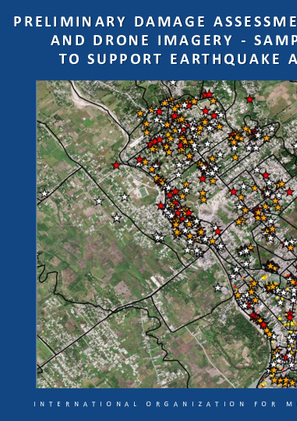
Contact
dtmhaiti@iom.int
Language
English
Location
Haiti
Snapshot Date
Aug 14 2021
Activity
- Other
In Les Cayes centre ville where WB drone imagery overlaps with the satellite imagery from DigitalGlobe , the Copernicus
EMS photo interpretation analysis revealed 66 buildings:
- 2 destroyed (red)
- 21 damaged (orange)
- 43 possibly damaged (white)
Contact
Location
Thailand
Activity
- Survey
- Flow Monitoring
Period Covered
Nov 11 2021 -Feb 13 2022
From mid-November 2021 to mid-February 2022, a total of 4,429 surveys were collected among Cambodian and Myanmar migrants in the provinces of Chanthaburi, Chonburi, Ranong, Rayong, Tak, Trat, and Greater Bangkok Area. The findings help to identify attitudes and perceptions on COVID-19 vaccination, gauge the prevalence of vaccine acceptance among migrant communities in Thailand, and better understand the reasons for vaccine hesitancy. Additionally, the findings can be used to predict the trends about future vaccine uptake among these migrant communities and, consequently, develop strategies to improve acceptability and inform policy and possible responses to flatten the COVID-19 infection curve.
Population Groups
Survey Methodology
Unit of Analysis Or Observation
Type of Survey or Assessment
Keywords
Geographical Scope
Administrative boundaries with available data
The current dataset covers the following administrative boundaries
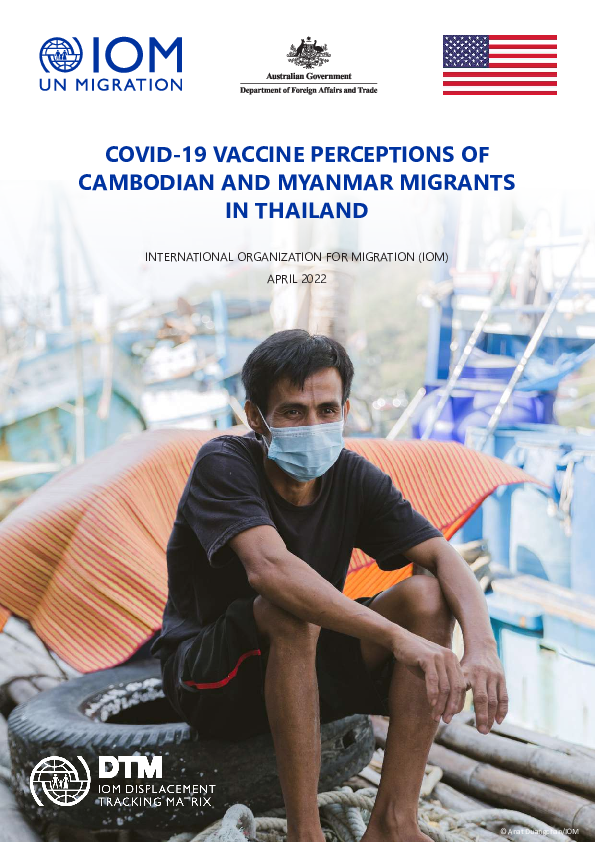
Contact
DTM Thailand, dtmthailand@iom.int
Language
English
Location
Thailand
Period Covered
Nov 11 2021
Feb 13 2022
Activity
- Survey
- Community Perception
From mid-November 2021 to mid-February 2022, a total of 4,429 surveys were collected among Cambodian and Myanmar migrants in the provinces of Chanthaburi, Chonburi, Ranong, Rayong, Tak, Trat, and Greater Bangkok Area. The findings help to identify attitudes and perceptions on COVID-19 vaccination, gauge the prevalence of vaccine acceptance among migrant communities in Thailand, and better understand the reasons for vaccine hesitancy. Additionally, the findings can be used to predict the trends about future vaccine uptake among these migrant communities and, consequently, develop strategies to improve acceptability and inform policy and possible responses to flatten the COVID-19 infection curve.

Contact
DTMMozambique@iom.int
Language
English
Location
Mozambique
Period Covered
Apr 13 2022
Apr 19 2022
Activity
- Event Tracking
- Mobility Tracking
During the reporting period (13 to 19 April 2022), a total of 41 movements were recorded - 8 returns (3,851 individuals), 28 arrivals (776 individuals), and 3 departures (20 individuals). The largest return movements were recorded in Muidumbe (3,827 individuals) and Palma (20 individuals). The largest arrival movements were recorded in Nangade (450 individuals) and Macomia (208 individuals). The largest departure was observed in Ibo (13 individuals). Of the total population, 11 per cent of mobile groups were displaced for the first time, and 89 per cent of reported individuals have been displaced more than once prior to this movement.

Contact
DTM Nigeria, AllUsersInDTMNigeria@iom.int
Language
English
Location
Nigeria
Period Covered
Jan 03 2022
Jan 31 2022
Activity
- Other
In the BAY states of North-east Nigeria (Borno, Adamawa and Yobe), various conflict escalations have been noted in recent times. The security situation remains unpredictable and leads to fluid mobility. Some violent attacks by NSAG (Non-State Armed Groups) were recorded in the last months of 2021 against IDPs, returnees and aid workers. At present, the humanitarian situation is rapidly approaching famine levels and is characterised by high levels of food insecurity, malnutrition and exposure to diseases.
Additionally, recent efforts by the Borno State Government (BSG) to shut down displacement camps in the urban centres of Borno State have created several risks and hardships. Many IDPs who resided in the camps have now integrated in camps and host communities in their LGAs of origin. In most cases, the security situation in areas of origin is still considered unsafe and does not allow for a safe return to their villages. The influx of IDPs in the respective LGAs has resulted in additional pressure on already stretched facilities and services across the camps and host communities.
In order to find durable solutions for internal displacement — whether through return to communities of origin, local integration, or relocation — and to prevent new displacements in the region, it is critical to understand the relative levels of stability in locations hosting returnees or displaced populations. Therefore, IOM has launched the Stability Index (SI) in Nigeria, to evaluate the stability of areas hosting returnees or displaced populations. The SI seeks to understand which factors influence a location's stability, which can inform priority programmatic interventions along the humanitarian, peace and development nexus in order to strengthen the resilience and stability and prevent future forced displacements.
This report presents the result from the second Stability Index round conducted in January 2022 in Nigeria’s BAY states (Borno, Adamawa and Yobe).

Contact
DTM Nigeria, AllUsersInDTMNigeria@iom.int
Language
English
Location
Nigeria
Period Covered
Apr 11 2022
Apr 17 2022
Activity
- Event Tracking
- Mobility Tracking
The DTM Emergency Tracking Tool (ETT) is deployed to track and to collect information on large and sudden population movements, provide frequent updates on the scale of displacement and quantify the affected population when needed. As a sub-component of the Mobility Tracking methodology in Nigeria. ETT utilises direct observation and a broad network of key informants to capture best estimates of the affected population per location, enabling targeted humanitarian response planning.
Between 11 and 17 April 2022, a total of 2,081 movements were recorded in Adamawa and Borno States. The recorded movements consisted of 1,632 arrivals and 449 departures. Arrivals were recorded at locations in Askira/Uba, Bama, Gwoza, Kala/Balge, Monguno and Ngala Local Government Areas (LGAs) of the most conflict-affected state of Borno and in Fufore, Gombi, Hong, Lamurde, Maiha, Michika, Mubi North, Mubi South, Song, Yola North and Yola South LGAs of Adamawa State.
Departures were recorded in Askira/Uba and Bama LGAs of Borno State and in Fufore, Gombi, Hong, Lamurde, Michika, Mubi North, Numan and Song LGAs of Adamawa State. ETT assessments identified the following movement triggers: voluntary relocation (1,033 individuals or 49%), poor living conditions (391 individuals or 19%), military operations (332 individuals or 16%), improved security (205 individuals or 10%) and seasonal farming (120 individuals or 6%).
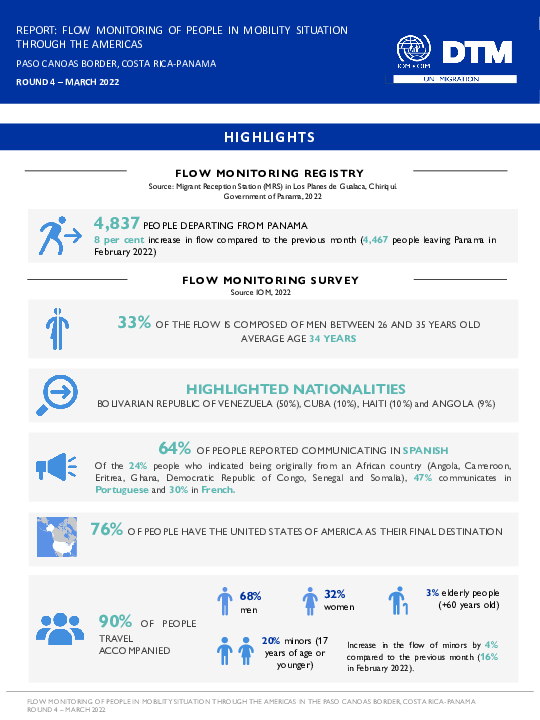
Contact
Angelica Madrigal amadrigal@iom.int / Miranda Mora mmora@iom.int
Language
English
Location
Costa Rica
Period Covered
Mar 01 2022
Mar 31 2022
Activity
- Flow Monitoring
In the framework of the COVID-19 emergency, since March 19, 2020, the Government of Costa Rica has kept its land border with Panama closed for the Controlled Flow Binational Operation, which sought an orderly and safe migration of migrants moving through the Americas.
Between August 2021 and January 2022, 93,139 migrants entered Panama: Haiti (61%), Cuba (11%), Chile and Brazil with 7 percent, Bolivarian Republic of Venezuela (4%), among other countries in South America, Africa, and Asia (10%).
In Costa Rica, during 2022, a steady increase in the number of migrants of this migration flow has been identified (it had increased by 26 percent compared to December 2021, when the flow monitoring in Costa Rica began). In addition, according to data from the General Directorate of Migration and Foreigners (DGME), between May 2021 and February 2022, 5,331 rejections were made in Paso Canoas.
In Costa Rica, there are many perceived vulnerabilities: people traveling alone, children, disoriented elderly people, people with medical problems, emotional exhaustion caused by stress, anguish, and frustration. In addition, the principal needs detected are associated with access to food, clothing, diapers, shelter, medicines, and transportation. Many people have lost their identification documents and are reluctant to receive medical assistance as they believe that they will not be allowed to continue their journey.
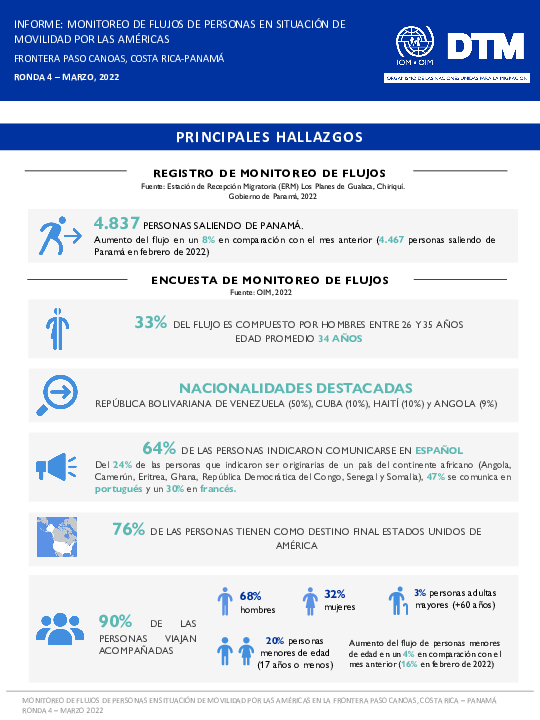
Contact
Angelica Madrigal amadrigal@iom.int / Miranda Mora mmora@iom.int
Language
Spanish
Location
Costa Rica
Period Covered
Mar 01 2022
Mar 31 2022
Activity
- Flow Monitoring
En el marco de la emergencia por la COVID-19, desde el 19 de marzo del 2020, el Gobierno de Costa Rica mantiene cerrada su frontera terrestre con Panamá para la Operación Binacional Flujo Controlado, la cual procuraba una migración ordenada y segura de personas migrantes en situación de movilidad por América3.
Desde agosto de 2021 y enero de 2022, han ingresado a Panamá 93.139 personas migrantes: Haití (61%), Cuba (11%), Chile y Brasil con 7%, República Bolivariana de Venezuela (4%), entre otros países del Sur de América, África y Asia (10%).
En Costa Rica, durante el 2022, se ha identificado un aumento constante en la cantidad de personas migrantes de este flujo migratorio (ha aumentado en un 26% en comparación con diciembre, 2021, cuando inició el monitoreo de flujos en Costa Rica). Además, de acuerdo con datos de la Dirección General de Migración y Extranjería (DGME), durante mayo de 2021 y febrero de 2022 se han realizaron 5.331 rechazos5 en Paso Canoas.
En Costa Rica se perciben muchas vulnerabilidades: personas viajando solas, niños y niñas, personas adultas mayores desorientadas, personas con problemas médicos, desgaste emocional ocasionado por estrés, angustia y frustración. Además, las principales necesidades detectadas se asocian con el acceso a alimento, ropa, pañales, alojamiento, medicamentos y transporte. Muchas personas han perdido sus documentos de identificación y se reúsan a recibir asistencia médica, pues consideran que no se les permitiría continuar con su viaje.

Contact
DTMAfghanistan@iom.int
Language
English
Location
Afghanistan
Period Covered
Dec 04 2021
Jan 01 2022
Activity
- Other
This report provides a snapshot of the third round of RLS data collection, as well as a comparison of data that was collected among those returnees who also participated in the second round (September-October 2021). Round 3 of RLS data collection took place between 4 December 2021 and 1 January 2022 with Afghan migrants who returned from Turkey or the EU between January 2018 and July 2021. 666 returnees (577 from Turkey and 89 from the EU) were interviewed in-person and over the phone across 92 districts in 15 provinces.
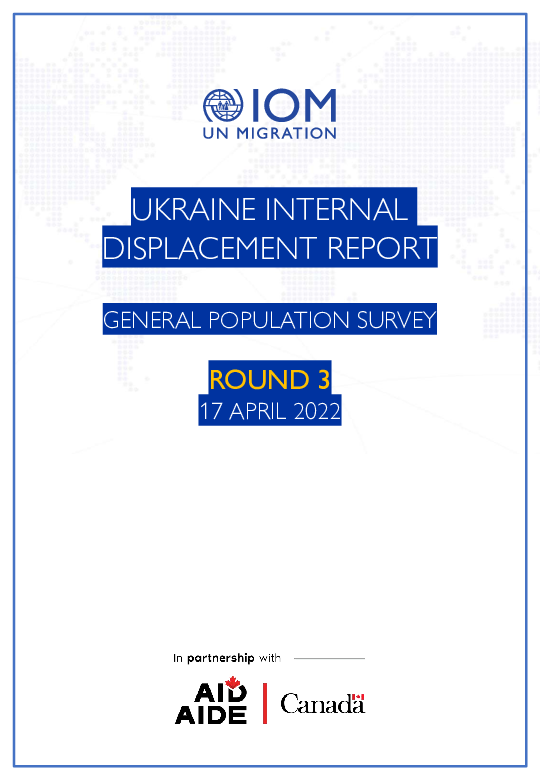
Contact
DTMUkraine@iom.int
Language
English
Location
Ukraine
Period Covered
Apr 11 2022
Apr 17 2022
Activity
- Survey
Starting on 24 February 2022 the war in Ukraine triggered an unprecedented humanitarian crisis across all of the country’s sub regional divisions (oblasts). Between 11 April and 17 April the International Organization for Migration (IOM) conducted the third round of a rapid representative assessment of the general population in Ukraine to gather insights into internal displacement and mobility flows, and to assess local needs. This general population survey serves as a preliminary source to identify areas with high humanitarian needs and to inform the targeting of response aiming to assist the war affected population. The geographical scope of the assessment covers the entire territory of Ukraine, all five macro regions ( East, North, Centre, South, and the city of Kyiv), with the exception of the Crimean peninsula. The general population survey was constructed through a random-digit-dial (RDD) approach, and 2,000 unique and anonymous respondents aged 18 and over were interviewed using the computer-assisted telephone interview (CATI) method. The estimates rely on the UNFPA population data for Ukraine, agreed upon as the common population baseline by the humanitarian community. Those currently outside Ukraine were not interviewed. For further notes on method and limitations, including IOM’s definition of internally displaced persons used for the purpose of this assessment, see page 11.
This report is also available in Ukrainian.